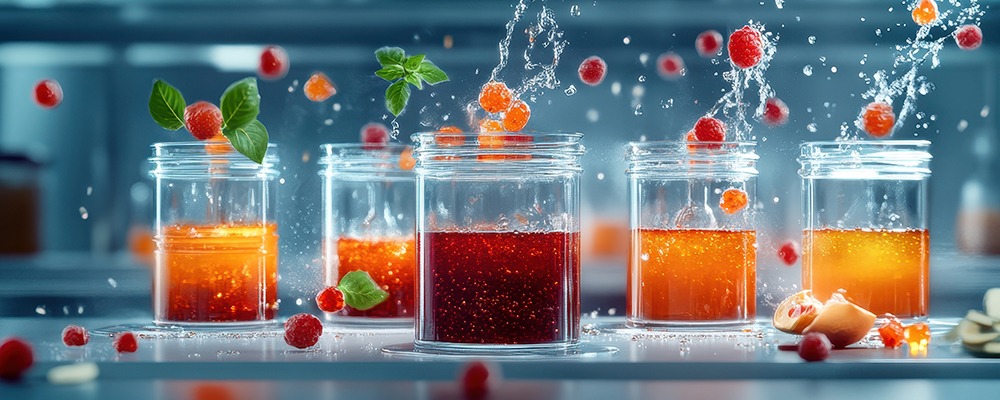When it comes to fruit juice production, consumers expect a product that is not only refreshing and nutritious but also visually appealing. A clear, bright juice with a stable shelf life is the gold standard for premium-quality beverages. However, achieving such clarity is not as simple as it may seem. Natural fruit juices contain a host of complex compounds, including pectins, starches, and proteins, that can lead to haziness and sedimentation. This is where enzymes play a crucial role in juice processing.
Enzymes are natural catalysts that accelerate biochemical reactions without being consumed in the process. In fruit juice production, they break down undesirable components that cause turbidity, improving both clarity and yield. The use of enzymes in juice clarification is a well-established practice that enhances not only the visual quality but also the flavour, aroma, and overall stability of the final product. This blog explores why enzymes are essential for producing high-quality, clear juices and how they contribute to efficiency and sustainability in the juice industry.
Understanding Juice Haze and Its Causes
Before delving into the role of enzymes, it is important to understand why fruit juices tend to be cloudy. The primary culprits behind juice haze include:
- Pectins: These are complex polysaccharides found in plant cell walls, particularly in fruits like apples, pears, and citrus. Pectins act as natural thickeners, causing cloudiness and increasing viscosity.
- Starches: Some fruits, such as bananas and mangoes, contain starch that contributes to opacity and sedimentation over time.
- Proteins and Polyphenols: These compounds can interact to form insoluble complexes, leading to turbidity in juices like grape and cranberry.
- Cell Wall Debris: Fruit pulp and micro-particles suspended in juice contribute to its cloudy appearance.
While filtration and centrifugation can help remove some of these unwanted elements, they are not entirely effective. Enzymatic treatment is the most efficient and natural way to achieve clarity without compromising the juice’s flavour or nutritional value.
The Role of Enzymes

Enzymes work by breaking down the structural components responsible for turbidity. In juice processing, several key enzymes are employed to improve clarity, yield, and overall juice quality.
- Pectinases: Breaking Down Pectins
Pectinase enzymes, including polygalacturonases and pectin lyases, are the most commonly used in juice clarification. These enzymes break down pectins into simpler molecules, reducing viscosity and allowing suspended particles to settle. Without pectin degradation, filtration becomes difficult, leading to higher processing costs and lower yields.
By hydrolysing pectin, pectinases improve juice flow during pressing, increasing extraction efficiency and producing a higher volume of juice from the same raw material. The result is a smoother, clearer juice with enhanced stability.
- Amylases: Eliminating Starch Haze
Starch contributes to juice cloudiness, particularly in fruits such as apples, pears, and tropical fruits. Amylase enzymes break down starch into smaller sugars, preventing sedimentation during storage.
This enzymatic treatment is especially beneficial for juice concentrates, as starch haze can become more pronounced when juice is stored or transported at low temperatures. By incorporating amylases into processing, manufacturers can ensure their juices remain visually appealing and do not develop haze over time.
- Proteases: Preventing Protein-Polyphenol Complex Formation
Proteins and polyphenols can form insoluble complexes that cause persistent turbidity. Protease enzymes help break down proteins, preventing unwanted interactions and improving filtration efficiency. This is particularly important in grape and berry juices, where polyphenols are abundant.
- Hemicellulases and Cellulases: Enhancing Extraction and Filtration
Hemicellulases and cellulases target plant cell walls, breaking down cellulose and hemicellulose. This improves juice extraction, reduces the need for excessive mechanical pressing, and enhances overall clarity. These enzymes are particularly valuable in processing fruits with high fibre content, such as berries and citrus.
Benefits of Enzyme Treatment in Juice Production
The use of enzymes in juice clarification offers multiple advantages beyond just improving clarity.
- Increased Juice Yield
Enzymatic treatment enhances juice extraction from fruit pulp, reducing waste and maximising output. This is especially crucial in large-scale juice production, where efficiency directly impacts profitability.
- Improved Filtration Efficiency
By breaking down pectins and starches, enzymes facilitate faster and more effective filtration. This reduces the need for mechanical processing, lowering energy costs and minimising wear and tear on filtration equipment.
- Better Colour and Flavour Retention
Hazy juices often require extensive processing to remove unwanted compounds, which can strip away natural colour and flavour. Enzyme treatment ensures that juices retain their vibrant hues and fresh, authentic taste.
- Enhanced Shelf Stability
Sedimentation and haze formation over time can affect a juice’s appeal. Enzymes prevent these issues, resulting in a more stable product with an extended shelf life.
- Eco-Friendly and Cost-Effective Processing
Enzymatic clarification reduces the need for synthetic clarifying agents and excessive filtration, making the process more environmentally friendly. It also lowers operational costs by improving efficiency and reducing waste.
Application of Enzymes in Different Types of Juices

Apple and Pear Juices
Pectinases and amylases play a crucial role in apple and pear juice production. These enzymes help break down pectin and starch, ensuring a clear and bright final product.
Citrus Juices
Pectinases and cellulases are widely used to improve clarity and yield in orange, lemon, and lime juices. They also enhance juice extraction from citrus peel, reducing waste.
Grape and Berry Juices
Proteases and polyphenol-targeting enzymes prevent haze caused by protein-polyphenol interactions. This results in a clearer, more stable juice with better filtration properties.
Tropical Fruit Juices (Mango, Pineapple, Papaya)
These fruits contain high levels of starch and fibre, making amylases and cellulases essential for achieving smooth and transparent juices.
Future Trends in Enzyme-Based Juice Processing
With growing consumer demand for natural and minimally processed beverages, enzymatic treatment is becoming increasingly important. Advances in enzyme technology are leading to more specific and efficient formulations tailored to different fruit types. Additionally, sustainable processing methods are gaining traction, with enzyme solutions helping manufacturers reduce waste and energy consumption.
Research is also focusing on multi-enzyme formulations that can simultaneously target multiple haze-causing compounds, further improving efficiency. As the juice industry continues to evolve, enzymes will remain a cornerstone of high-quality, natural juice production.
Conclusion
Enzymes are indispensable in the quest for high-quality, clear juices. They not only enhance clarity but also improve juice yield, flavour, stability, and overall processing efficiency. By breaking down pectins, starches, and proteins, enzymes ensure that juices maintain their visual appeal and natural goodness, meeting consumer expectations for premium beverages.
At Biolaxi Enzymes, we specialise in providing advanced enzyme solutions tailored for juice processing. Our high-quality, customised formulations help juice manufacturers achieve superior clarity, increased yields, and optimised production efficiency. With a commitment to innovation, quality, and sustainability, Biolaxi Enzymes is your trusted partner in crafting clear, refreshing, and high-quality fruit juices.




